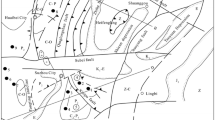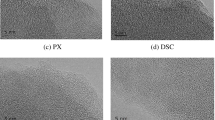Abstract
There is a more consanguineous relation between nano-scale deformation of coal structure and metamorphic-deformed environment. In different metamorphic-deformed environments, deformation in the coal structure can occur not only at micro-scale, but also at nano-scale, and even leads to the change of molecular structure and nano-scale pore (< 100 nm) structure. The latter is the main space absorbing coalbed methane. Through X-ray diffraction (XRD) and liquid—nitrogen absorption methods, the characteristics of macromolecular and nano-scale pore structures of coals in different metamorphic-deformed environments and deformational series of coals have been studied. By combining with high-resolution transmission electron microcopy (HRTEM), the macromolecular and nano-scale pore structures are also directly observed. These results demonstrate that the stacking Lc of the macromolecular BSU in tectonic coals increases quickly from the metamorphic-deformed environment of low rank coals to that of high rank coals. For different deformed tectonic coals, in the same metamorphic-deformed environment, the difference of Lc is obvious. These changes reflect chiefly the difference of different temperature and stress effect of nano-scale deformation in tectonic coals. The factor of temperature plays a greater role in the increase of macromolecular structure parameters Lc, the influence of stress factor is also important. With the stress strengthening, Lc shows an increasing trend, and LaLc shows a decreasing trend. Therefore, Lc and LaLc can be used as the indicator of nano-scale deformation degree of tectonic coals. With increasing temperature and pressure, especially oriented stress, the orientation of molecular structure becomes stronger, and ordering degree of C-nets and the arrangement of BSU are obviously enhanced. For the deformation of nano-scale pore structure, in the same metamorphic-deformed environment, along with the strengthening of stress, the ratio of mesopores to its total pores volume of tectonic coals reduces to a large extent, the ratio of volume of micropores and the pores whose diameters are lower than micropores increases, and sub-micropores and ultra-micropores can be found. Moreover, the ratio of specific surface area of mesopores to its total pores reduces rapidly while the amount of sub-micropores increases more quickly. The ductile structure coal has a change in pore parameters similar to that of weak brittle deformation. There are differences in the deformation and evolution of nano-scale pore structure of different kinds of tectonic coals formed in different metamorphic-deformational environments. In short, temperature and confining pressure play some role in the change of nano-scale pore structure parameters, whereas stress has important influence on the evolution of characteristic parameters in nano-scale pore structure of tectonic coals.
Similar content being viewed by others
References
Hower, J. C., Observation on the role of Bernice coal field (Sullivan County, Pennsylvania) anthracites in the development of coalification theories in the Appalachians, Int. J. Coal Geol., 1997, 33: 95–102.
Taylor, G. H., Teichmüller, M., Davis, A. et al., Organic Petrology, Berlin: Gebrüder Borntraeger, 1998, 10–205.
Yao, D. X., Lu, J., Study on prosity of coal from the First Mine, Xiejiaji, Huainan, Coal Geology of China (in Chinese), 1996, 8 (4): 31–33.
Zhang, J., Yu, B., Tang, J. X., Study on pore structures of coal seam Blowing out gas, Coal Geology of China (in Chinese), 1996, 8(2): 71–74.
Duber, S., Rouzaud, J. N., Calculation of reflectance values for two models of texture of carbon materials, Int. J. Coal Geol., 1999, 38: 333–348.
Cao, Y. X., Mitchell, G. D., Davis, A. et al., Deformation metamorphism of bituminous and anthracite coals from China, Int. J. Coal Geol., 2000, 43: 227–242.
Cao, Y. X., Davis A., Liu R. X. et al., The influence of tectonic deformation on some geochemical properties of coals-a possible indication of outburst potential, Int. J. Coal Geol., 2003, 53: 69–79.
Beamish, B. B., Crosdale, J. P., Instantaneous outbursts in underground coal mines: An overview and association with coal type, Int. J. Coal Geol., 1998, 35: 27–55.
Ju, Y. W., Wang, G. L., Rheology of coal seams and their relation with gas outbursts: a case study of the Haizi Coal Mine, Huaibei Coalfield, Geological Review (in Chinese), 2002, 48(1): 96–105.
Weng, C. M., Pan, Z. G., X-ray diffraction analysis of coal in Fengfeng coalfield, Earth Science—Journal of Wuhan College of Geology, 1981, (1): 214–221.
Gregg, S. J., Sing, K. S., Adsorption, Surface Area and Porosity, 2nd ed, New York: Academic Press Inc. 1982, 32–150, 290–330.
Zhong, L. W., Zhang, H., Yun, Z. R. et al., Influence of pore area and pore volume of coal on adsorption capacity, Coal Geology & Exploration (in Chinese), 2002, 30(3): 26–29.
Stach, E., Mackowsky, M-TH. Teichmüller, M. et al., Stach’s Textbook of Coal Petrology, Berlin: Gebruder Borntraeger, 1982, 381–413.
Yang, Q., The Coal Metamorphism in China (in Chinese), Beijing: China Coal Industry Publishing House, 1996, 150–197.
Qin, Y., Micropetrology and Structural Evolution of High-rank Coals in P. R. China (in Chinese), Xuzhou: China University of Mining & Technology Press, 1994, 48–137.
Wang, G. L., Zhu, Y. M., Study on the rheology of coal bed, Journal of China Institute of Mining & Technology (in Chinese), 1988, (3): 16–25.
Oberlin, A., High resolution TEM studies of carbonization and graphitization, Chem. Phys. Carbon, 1992, 22: 1–14.
Wilks, K. R., Mastalerz, M., Bustin, R. M. et al., The role of shear strain in the graphitization of high-volatile bituminous and anthracite coals, Int. J. Coal Geol., 1993, 22: 247–277.
Bustin, R. M., Ross, J. V., Rouzaud, J. N., Mechanisms of graphite formation from kerogen: experimental evidence, Int. J. Coal Geol., 1995, 28: 1–36.
Author information
Authors and Affiliations
Corresponding author
About this article
Cite this article
Ju, Y., Jiang, B., Hou, Q. et al. Relationship between nanoscale deformation of coal structure and metamorphic-deformed environments. Chin.Sci.Bull. 50, 1785–1796 (2005). https://doi.org/10.1360/04wd0205
Received:
Accepted:
Issue Date:
DOI: https://doi.org/10.1360/04wd0205




